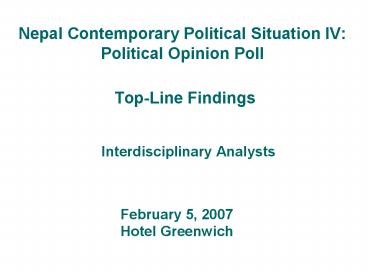Nepal Contemporary Political Situation IV: - PowerPoint PPT Presentation
1 / 75
Title:
Nepal Contemporary Political Situation IV:
Description:
Nepal Contemporary Political Situation IV: Political Opinion Poll. Top-Line Findings ... 3. Nepal Contemporary Political Situation II: Opinion Poll Report (2006) ... – PowerPoint PPT presentation
Number of Views:255
Avg rating:3.0/5.0
Title: Nepal Contemporary Political Situation IV:
1
Nepal Contemporary Political Situation IV
Political Opinion Poll
Top-Line Findings
Interdisciplinary Analysts
February 5, 2007 Hotel Greenwich
2
Rationale
- The consensus among the Seven Party Alliance
(SPA), the CPN Maoists and other political
parties for elections to the constituent
assembly, which will then draft a new
constitution. - It is important that constituent assembly
deliberations are able to give voice to
communities whose concerns have generally not
been audible. - Once the voice of such disenfranchised
communities is made audible and are listened to,
the new constitution drafting process would be
much more inclusive than had been the case in the
past. - However, for this to happen it is important to
inform all the communities, including
marginalized ones, about constituent assembly.
3
Objectives
- The main objective of the opinion poll is to
document the level of knowledge among the people
at large on the processes and contents of
constituent assembly.
4
- Specific objectives
- To assess the level of knowledge among the people
disaggregated on the basis of caste/ethnicity,
gender, urban-rural divide, development-geographic
al region, religion, etc. - on constitution
assembly process and contents. - To help formulate messages and target communities
to enable them be more actively educated on the
constituent assembly. - To gauge peoples opinion about the issues
pertaining to state re-structuring and related
issues such as monarchy vs. republicanism,
federalism vs. unitary system, proportional
representative electoral system vs.
majority-based electoral system, single state
language policy vs. multiple language policy,
Hindu state vs. secular state, affirmative
actions to Dalits and women, etc. - To identify changes, if any, in people's
perception on major political issues.
5
Related works by Interdisciplinary Analysts
(Sudhindra Sharma Pawan Kumar Sen)
- 1999 General Election Opinion Poll
- How Voters Assess Politics, Parties and
Politicians - Nepal Contemporary Political Situation
- Opinion Poll Report (2005)
- Fieldwork done in December 2004
- 3. Nepal Contemporary Political Situation II
- Opinion Poll Report (2006)
- Fieldwork done in January 2006
- 4. Nepal Contemporary Political Situation
III - Opinion Poll Report (2006)
- Fieldwork done in September 2006
- Interdisciplinary Analysts is grateful to
The Asia Foundation for the financial support in
undertaking longitudinal opinion polls.
Interdisciplinary Analysts was assisted by AC
Neilson for the fieldwork of NSPS I II, while
Blitz Media rendered assistance for the fieldwork
of NCPS III.
6
(No Transcript)
7
(No Transcript)
8
(No Transcript)
9
(No Transcript)
10
(No Transcript)
11
(No Transcript)
12
Methodology
Closed-ended questionnaire 2,011 respondent
s 21 purposely selected districts Criter
ia for selecting districts is caste/ethnicity
Sample districts represent 5 development regio
ns and 3 ecological zones From every sam
ple district, 4 VDCs were selected
purposely maintaining consistency with caste/
ethnicity composition of population
4 sample VDCs within a sample district a
) one is VDC where District HQ is located
b) another one is VDC nearby HQ
c) other two are VDCs loacated far away from
HQ
13
Sampling at the district level
FW Mount
MW Mount
West Mount
FW Hill
East Mount
Central Mount
MW Hill
West Hill
East Hill
Central Hill
FW Tarai
West Tarai
MW Tarai
Central Tarai
East Tarai
14
(No Transcript)
15
Sample Characteristics
16
Sample Characteristics cont
17
Sample Characteristics cont
18
Sample Characteristics cont
19
Sample Characteristics cont
20
(No Transcript)
21
Sample Characteristics cont
22
Sample Characteristics cont
23
Fieldwork Planning and Some Experiences
- Team Formulation
- Duration (Dec 22, 2006 Jan 13, 2007)
- Experiences
- Sindhupalchowk
- Rolpa
- Banke
24
Key Findings
25
Publics understanding of the constituent assembly
26
The trend suggests that not only have more
people heard the term but also more people
understand the term correctly. However, compared
to those who have heard about constituent
assembly, there is only a small increase in those
who correctly understand it.
27
(No Transcript)
28
(No Transcript)
29
(No Transcript)
30
(No Transcript)
31
(No Transcript)
32
(No Transcript)
33
(No Transcript)
34
(No Transcript)
35
36
(No Transcript)
37
38
(No Transcript)
39
(No Transcript)
40
(No Transcript)
41
42
(No Transcript)
43
(No Transcript)
44
(No Transcript)
45
(No Transcript)
46
(No Transcript)
47
(No Transcript)
48
49
(No Transcript)
50
(No Transcript)
51
(No Transcript)
52
(No Transcript)
53
(No Transcript)
54
(No Transcript)
55
(No Transcript)
56
(No Transcript)
57
(No Transcript)
58
(No Transcript)
59
(No Transcript)
60
61
(No Transcript)
62
(No Transcript)
63
64
(No Transcript)
65
(No Transcript)
66
67
Percentage of those favouring affirmative action
for Dalits and women
68
(No Transcript)
69
(No Transcript)
70
(No Transcript)
71
72
(No Transcript)
73
(No Transcript)
74
(No Transcript)
75
(No Transcript)































